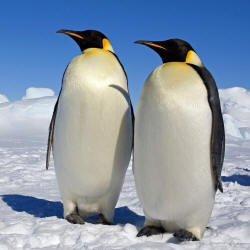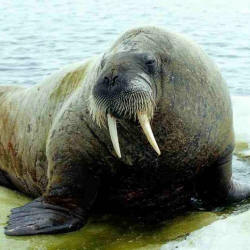World Animals
Polar Animals
Emperor Penguin

Animal Kingdom: Non-flying bird, Avec
Population: app. 595.000
Size: H: app. 1.1 m, W: app. 83 cm
Weight: 22 kg - 45 kg
Life Expectancy: 15 years - 50 years
Food source: Fish, fish and more fish!
Max. speed: 24 km/h
Nutritional value: Dangerous amount of quicksilver!
The Emperor Penguin (Aptenodytes forsteri) is the tallest and heaviest
of all living penguin species and is endemic to Antarctica. The male and
female are similar in plumage and size, reaching 122 cm (48 in) in
height and weighing anywhere from 22 to 45 kg (49 to 99 lb). The dorsal
side and head are black and sharply delineated from the white belly,
pale-yellow breast and bright-yellow ear patches. Like all penguins it
is flightless, with a streamlined body, and wings stiffened and
flattened into flippers for a marine habitat.
Its diet consists primarily of fish, but can also include crustaceans,
such as krill, and cephalopods, such as squid. In hunting, the species
can remain submerged up to 18 minutes, diving to a depth of 535 m (1,755
ft). It has several adaptations to facilitate this, including an
unusually structured hemoglobin to allow it to function at low oxygen
levels, solid bones to reduce barotrauma, and the ability to reduce its
metabolism and shut down non-essential organ functions.
The only penguin species that breeds during the Antarctic winter, the
Emperor Penguin treks 50–120 km (31–75 mi) over the ice to breeding
colonies which may include thousands of individuals. The female lays a
single egg, which is incubated by the male while the female returns to
the sea to feed; parents subsequently take turns foraging at sea and
caring for their chick in the colony. The lifespan is typically 20 years
in the wild, although observations suggest that some individuals may
live to 50 years of age.
Walros

Animal Kingdom: Enhanced seal, Mammal
Population: app. 250.000
Size: H: app. 1.5 m, L: app. 2.75 m
Weight: 0.4 ton - 1.7 tonnes
Life Expectancy: 40 years - 50 years
Food source: Penguins
Max. speed: 35 km/h
Nutritional value: Extreme levels of quicksilver!!
The walrus (Odobenus rosmarus) is a large flippered marine mammal with a
discontinuous distribution about the North Pole in the Arctic Ocean and
subarctic seas of the Northern Hemisphere. The walrus is the only living
species in the Odobenidae family and Odobenus genus. This species is
subdivided into three subspecies:[1] the Atlantic walrus (O. r.
rosmarus) which lives in the Atlantic Ocean, the Pacific walrus (O. r.
divergens) which lives in the Pacific Ocean, and O. r. laptevi, which
lives in the Laptev Sea of the Arctic Ocean.
Adult walruses are easily recognized by their prominent tusks, whiskers,
and bulkiness. Adult males in the Pacific can weigh more than 1,700 kg
(3,700 lb)[4] and, among pinnipeds, are exceeded in size only by the two
species of elephant seals.[5] Walruses live mostly in shallow waters
above the continental shelves, spending significant amounts of their
lives on the sea ice looking for benthic bivalve mollusks to eat.
Walruses are relatively long-lived, social animals, and they are
considered to be a "keystone species" in the Arctic marine regions.
The walrus has played a prominent role in the cultures of many
indigenous Arctic peoples, who have hunted the walrus for its meat, fat,
skin, tusks, and bone. During the 19th century and the early 20th
century, walruses were widely hunted and killed for their blubber,
walrus ivory, and meat. The population of walruses dropped rapidly all
around the Arctic region. Their population has rebounded somewhat since
then, though the populations of Atlantic and Laptev walruses remain
fragmented and at low levels compared with the time before human
interference.